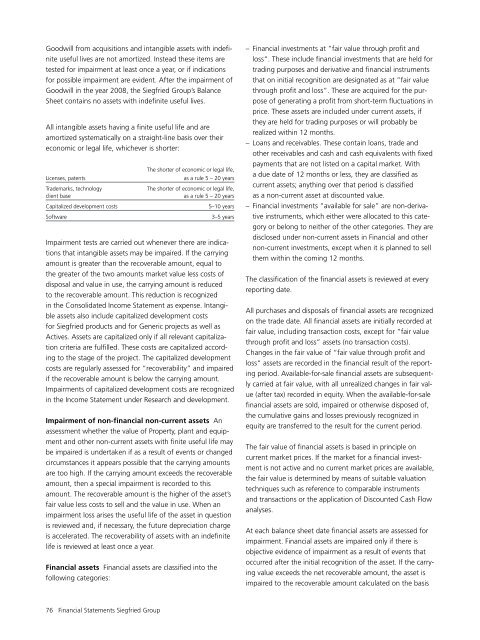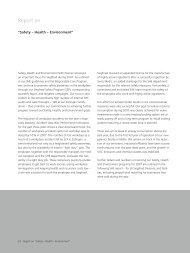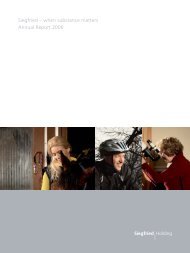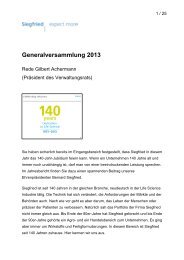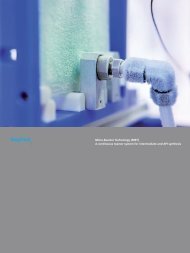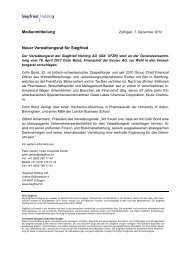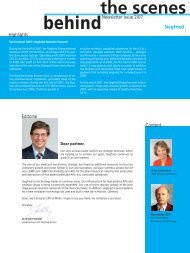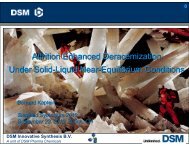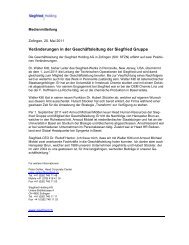Siegfried Annual Report 2009
Siegfried Annual Report 2009
Siegfried Annual Report 2009
You also want an ePaper? Increase the reach of your titles
YUMPU automatically turns print PDFs into web optimized ePapers that Google loves.
Goodwill from acquisitions and intangible assets with indefinite<br />
useful lives are not amortized. Instead these items are<br />
tested for impairment at least once a year, or if indications<br />
for possible impairment are evident. After the impairment of<br />
Goodwill in the year 2008, the <strong>Siegfried</strong> Group’s Balance<br />
Sheet contains no assets with indefinite useful lives.<br />
All intangible assets having a finite useful life and are<br />
amortized systematically on a straight-line basis over their<br />
economic or legal life, whichever is shorter:<br />
Licenses, patents<br />
Trademarks, technology<br />
client base<br />
Capitalized development costs<br />
Software<br />
The shorter of economic or legal life,<br />
as a rule 5 – 20 years<br />
The shorter of economic or legal life,<br />
as a rule 5 – 20 years<br />
5–10 years<br />
3–5 years<br />
Impairment tests are carried out whenever there are indications<br />
that intangible assets may be impaired. If the carrying<br />
amount is greater than the recoverable amount, equal to<br />
the greater of the two amounts market value less costs of<br />
disposal and value in use, the carrying amount is reduced<br />
to the recoverable amount. This reduction is recognized<br />
in the Consolidated Income Statement as expense. Intangible<br />
assets also include capitalized development costs<br />
for <strong>Siegfried</strong> products and for Generic projects as well as<br />
Actives. Assets are capitalized only if all relevant capitalization<br />
criteria are fulfilled. These costs are capitalized according<br />
to the stage of the project. The capitalized development<br />
costs are regularly assessed for “recoverability” and impaired<br />
if the recoverable amount is below the carrying amount.<br />
Impairments of capitalized development costs are recognized<br />
in the Income Statement under Research and development.<br />
Impairment of non-financial non-current assets An<br />
assessment whether the value of Property, plant and equipment<br />
and other non-current assets with finite useful life may<br />
be impaired is undertaken if as a result of events or changed<br />
circumstances it appears possible that the carrying amounts<br />
are too high. If the carrying amount exceeds the recoverable<br />
amount, then a special impairment is recorded to this<br />
amount. The recoverable amount is the higher of the asset’s<br />
fair value less costs to sell and the value in use. When an<br />
impairment loss arises the useful life of the asset in question<br />
is reviewed and, if necessary, the future depreciation charge<br />
is accelerated. The recoverability of assets with an indefinite<br />
life is reviewed at least once a year.<br />
Financial assets Financial assets are classified into the<br />
following categories:<br />
– Financial investments at ”fair value through profit and<br />
loss“. These include financial investments that are held for<br />
trading purposes and derivative and financial instruments<br />
that on initial recognition are designated as at ”fair value<br />
through profit and loss”. These are acquired for the purpose<br />
of generating a profit from short-term fluctuations in<br />
price. These assets are included under current assets, if<br />
they are held for trading purposes or will probably be<br />
realized within 12 months.<br />
– Loans and receivables. These contain loans, trade and<br />
other receivables and cash and cash equivalents with fixed<br />
payments that are not listed on a capital market. With<br />
a due date of 12 months or less, they are classified as<br />
current assets; anything over that period is classified<br />
as a non-current asset at discounted value.<br />
– Financial investments “available for sale” are non-derivative<br />
instruments, which either were allocated to this category<br />
or belong to neither of the other categories. They are<br />
disclosed under non-current assets in Financial and other<br />
non-current investments, except when it is planned to sell<br />
them within the coming 12 months.<br />
The classification of the financial assets is reviewed at every<br />
reporting date.<br />
All purchases and disposals of financial assets are recognized<br />
on the trade date. All financial assets are initially recorded at<br />
fair value, including transaction costs, except for “fair value<br />
through profit and loss” assets (no transaction costs).<br />
Changes in the fair value of “fair value through profit and<br />
loss“ assets are recorded in the financial result of the reporting<br />
period. Available-for-sale financial assets are subsequently<br />
carried at fair value, with all unrealized changes in fair value<br />
(after tax) recorded in equity. When the available-for-sale<br />
financial assets are sold, impaired or otherwise disposed of,<br />
the cumulative gains and losses previously recognized in<br />
equity are transferred to the result for the current period.<br />
The fair value of financial assets is based in principle on<br />
current market prices. If the market for a financial investment<br />
is not active and no current market prices are available,<br />
the fair value is determined by means of suitable valuation<br />
techniques such as reference to comparable instruments<br />
and transactions or the application of Discounted Cash Flow<br />
analyses.<br />
At each balance sheet date financial assets are assessed for<br />
impairment. Financial assets are impaired only if there is<br />
objective evidence of impairment as a result of events that<br />
occurred after the initial recognition of the asset. If the carrying<br />
value exceeds the net recoverable amount, the asset is<br />
impaired to the recoverable amount calculated on the basis<br />
76 Financial Statements <strong>Siegfried</strong> Group


